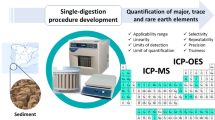Abstract
Marine sediments were dissolved by HNO3-HF-HClO4 in a sealed container at low pressure; HF was evaporated in an open container and salts were dissolved in HCl by heating, then transferred to 2% HNO3 solution. A total of 45 elements, including Li, Be, Sc, Ti, V, Cr, Mn, Co, Ni, Cu, Zn, Ga, Rb, Sr, Y, Zr, Nb, Mo, Cd, In, Sb, Cs, Ba, La, Ce, Pr, Nd, Sm, Eu, Gd, Tb, Dy, Ho, Er, Tm, Yb, Lu, Hf, Ta, W, Tl, Pb, Bi, Th and U, were measured by inductively coupled plasma mass spectrometry (ICP-MS). Conditions and sample experiments showed that this procedure defines a good experimental method which has the advantages of clear interference, easy operation and reliable results. The concentrations of the 45 elements could be used for resource exploration, environmental assessment and academic research.
Similar content being viewed by others

References
Cook, J. M., J. J. Robinson, S. R. N. Chenery, and D. L. Miles, 1997. Determining cadmium in marine sediments by inductively coupled plasma mass spectrometry: attacking the problems or the problems with the attack? Analyst, 122: 1207–1210.
Evans, E. H., and J. J. Giglio, 1993. Interferences in inductively coupled plasma mass spectrometry. J. Anal. At. Spectrom., 8: 1–18.
Fee, J. A., H. E. Gaudette, W. B. Lyons, and D. T. Long, 1992. Rare-earth element distribution in Lake Tyrrell groundwaters, Victoria, Australia. Chem. Geol., 96: 67–93.
Hall, G. E. M., J. E. Vaive, and J. W. McConnell, 1995. Development and application of a sensitive and rapid analytical method to determine the rare-earth elements in surface waters. Chem. Geol., 120: 91–109.
Jarvis, K. E., A. L. Gray, and R. S. Houk, 1997. Handbook of Inductively Coupled Plasma Mass Spectrometry. Yin M. and Li B. trans., Atomic Energy Press, Beijing.
Qingdao Institute of Marine Geology, 1989. Geochemical References of Deep Sea Ferromanganese Nodules and Sediments. MGMR Research Report-86086-18, 112pp (in Chinese).
Wang, Y., Y. Teng, D. Luo, and Y. Gao, 1997. Preparation of Pacific manganese nodule and sediment reference materials. Rock and Mineral Analysis, 16: 161–169 (in Chinese with English abstract).
Xia, N., S. Song, D. Yao, Z. Jiang, and L. Ji, 2001. Determination of adsorbed water in polymetallic nodules. Rock and Min. Anal., 20: 263–266 (in Chinese with English abstract).
Zhen, K., Z. Zhang, X. Zhang, and H. Ye, 2000. Determination of adsorbed water in marine sediments. Rock and Min. Anal., 19: 55–57 (in Chinese with English abstract).
Author information
Authors and Affiliations
Corresponding author
Rights and permissions
About this article
Cite this article
Xia, N., Wu, Z., Guo, D. et al. Multielement analysis of deep-sea sediments by inductively coupled plasma mass spectrometry. J. Ocean Univ. China 7, 137–144 (2008). https://doi.org/10.1007/s11802-008-0137-7
Received:
Accepted:
Published:
Issue Date:
DOI: https://doi.org/10.1007/s11802-008-0137-7



